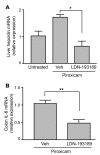Selective modulation of TLR4-activated inflammatory responses by altered iron homeostasis in mice
- PMID: 19809161
- PMCID: PMC2769199
- DOI: 10.1172/JCI39939
Selective modulation of TLR4-activated inflammatory responses by altered iron homeostasis in mice
Abstract
Mice deficient in the hemochromatosis gene, Hfe, have attenuated inflammatory responses to Salmonella infection associated with decreased macrophage TNF-alpha and IL-6 biosynthesis after exposure to LPS. In this study, we show that the abnormal cytokine production is related to impaired TLR4 signaling. Despite their abnormal response to LPS, Hfe KO macrophages produced amounts of TNF-alpha similar to those in WT cells after TLR2 stimulation. Consistent with this finding, LPS-induced activation of Mal/MyD88-dependent events was normal in the mutant macrophages. However, LPS-induced IFN-beta expression, a TRAM/TRIF-dependent response activated by TLR4, was reduced by Hfe deficiency. This reduction could be replicated in WT macrophages with the use of iron chelators. In contrast, TLR3-activated expression of IFN-beta, a TRIF-dependent response, was normal in Hfe KO macrophages and was unaffected by iron chelation. Our data suggest that low intracellular iron selectively impairs signaling via the TLR4/TRAM/TRIF pathway proximal to TRIF and results in reduced LPS-induced cytokine expression. Furthermore, by mimicking the altered iron metabolism associated with Hfe deficiency, we found that 3 different inhibitors of hepcidin attenuated Salmonella-induced and noninfectious enterocolitis. Thus, manipulation of iron homeostasis could represent a new therapeutic approach to controlling inflammation.
Figures








References
-
- Gordeuk V.R., McLaren C.E., MacPhail A.P., Deichsel G., Bothwell T.H. Associations of iron overload in Africa with hepatocellular carcinoma and tuberculosis: Strachan’s 1929 thesis revisited. Blood. 1996;87:3470–3476. - PubMed
-
- Moyo V.M., Gangaidzo I.T., Gordeuk V.R., Kiire C.F., Macphail A.P. Tuberculosis and iron overload in Africa: a review. Cent. Afr. J. Med. 1997;43:334–339. - PubMed
Publication types
MeSH terms
Substances
Grants and funding
LinkOut - more resources
Full Text Sources
Other Literature Sources
Medical
Molecular Biology Databases
Research Materials

